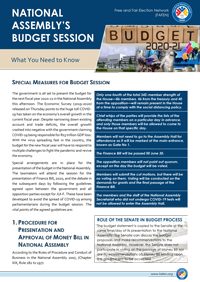ISLAMABAD, June 12, 2020: The government is all set to present the budget for the next fiscal year 2020-21 in the National Assembly this afternoon. The Economic Survey (2019-2020) released on Thursday points to the huge toll COVID-19 has taken on the economy’s overall growth in the current fiscal year. Despite narrowing down existing account and trade deficits, the overall growth crashed into negative with the government claiming COVID-19 being responsible for Rs3 trillion GDP loss. With the virus spreading fast in the country, the budget for the new fiscal year will have to respond to multiple challenges to fight the pandemic and revive the economy.
Special arrangements are in place for the presentation of the budget in the National Assembly. The lawmakers will attend the session for the presentation of Finance Bill, 2020, and the debate in the subsequent days by following the guidelines agreed upon between the government and all opposition parties except for JUI-F. These have been developed to avoid the spread of COVID-19 among parliamentarians during the budget session. The vital points of the agreed guidelines are:
- Only one-fourth of the total 342-member strength of the House—86 members, 46 from the treasury and 40 from the opposition—will remain present in the House at a time to comply with the social distancing policy.
- Chief whips of the parties will provide the lists of the attending members on a particular day in advance, and only those members will be allowed to come to the House on that specific day.
- Members will not need to go to the Assembly Hall for attendance as it will be marked at the main entrance, known as Gate No 1.
- The Finance Bill will be passed till June 30.
- The opposition members will not point out quorum, except on the day the budget will be voted.
- Members will submit the cut motions, but there will be no voting on them. Voting will be conducted on the demands for grants and the final passage of the Finance Bill.
The members and the staff of the National Assembly Secretariat who did not undergo COVID-19 tests will not be allowed to enter the Assembly Hall.
1. Procedure for Presentation and Approval of Money Bill in National Assembly
According to the Rules of Procedure and Conduct of Business in the National Assembly 2007, (Chapter XIX, Rule 182 to 197):
- The Leader of the House sets the date and time for the budget presentation in the House, and no demands for grants are made except on the recommendation of the government.
- The separate demands for grants are made in respect of the grant proposed by each ministry/division. Each demand contains a statement of the total grant suggested and an account of the detailed estimate under each grant divided into items.
- The minister for finance presents the budget. In his/her absence, a minister appointed by the prime minister will present it.
- The day the budget is presented, no other business is allowed in the House.
- After the budget is presented, the Speaker, after consultation with the minister in charge, allows the number of days for discussion and other stages of budget.
- At least four days are allocated for discussion. The House starts debate on the budget within 48 hours of its presentation.
i. Three stages of discussions on the Money Bill
- General discussion on the budget as a whole
- Discussion on grants for demands
- Voting
ii. General discussion on the budget as a whole
- As the legislators discuss the budget during the days reserved for general discussion, no motion is allowed to be tabled. Also, at this stage, the budget is not put to the vote. The Speaker may decide about the duration of the speeches.
- The finance minister has a general right of reply at the end of the discussion. In other words, the minister’s speech winds up the general debate on the budget.
iii. Cut motions
Cut motions are filed in written form two days before that particular item is to be taken up. Any member can move the cut motion to reduce the amount of demand. The Speaker has the final say on the admissibility of any cut motion. Amendments are not allowed in cut motions.
There are three types of cut motions:
- Disapproval of the Policy
- Economy Cut
- Token Cut
iv. Voting on Demands for Grants
- Voting on the demands for grants is the next stage. At this point, the cut motions, if any, are also disposed of. Each demand for a grant is treated and discussed separately.
- The schedule of authorized expenditure is placed in the House under Article 83 of the constitution and is not open to discussion or voting.
v.Supplementary and excess demands
- Supplementary and excess demands also undergo the procedure similar to usual demands for grants. If funds to meet the proposed expenditure on a new purpose are available by re-appropriation, a demand for the grant of a token sum is submitted to the vote of the Assembly and if the Assembly assents to the demand, funds are made available.
- The final stage involves the voting on the Finance Bill and passage.
2. Dos and Don’t in the Budget Session
- The minister for finance presents the budget. In his/her absence, any other minister authorized by the Leader of the House can present it.
- On the day the budget is presented, no other business including questions, calling attention notices, questions of privilege and adjournment motion can be transacted except the introduction of Finance Bill.
- There can be no discussion on the budget on the day it is presented to the assembly.
- The Leader of the Opposition traditionally opens the budget debate.
- Not less than four days can be allowed for the general discussion on the budget.
- On the days allotted for general discussion on the budget, the assembly can discuss it as a whole or any question of principle involved. During the general debate, neither cut motions are submitted, nor voting takes place.
- No adjournment motion can be moved on any day fixed for general discussion of the budget.
3. Budget Sessions in Recent Years
- On average, the Money Bill took 16 working days from introduction to the passage in the past seven years.
- From 2013 to 2019, each sitting in the National Assembly lasted five hours on average.
- The time allotted for general discussion on the budget in the last seven years was at least seven days for each session.
- As many as 155 demands for grants were made during the first year (2019-20) of the current government. The present government made 107 supplementary demands for grants.
- The proceedings of the budget sessions during the past seven years were halted 58 times due to protests, boycott, or walkouts by the members. It was halted 51 times through the tenure of the outgoing assembly and seven times during the only budget session of the current assembly.
- In the past seven years, the quorum was pointed out at least once every year except for the budget session in 2013. The highest number of incidents calling the attention of the chair on lack of quorum was eight times during the budget session in 2016-17.
- The Speaker and the Deputy Speaker’s attendance remained more than 90 percent during the budget sessions from 2013 to 2019.
- Prime Minister Imran Khan attended six out of 16 sittings during the budget session in 2019.
- The average attendance of members during budget sessions from 2013 to 2019 remained 228 (67 percent). The maximum average attendance (80 percent or 276 members) of lawmakers was recorded at the 2019 budget session.
To download in pdf, click here


